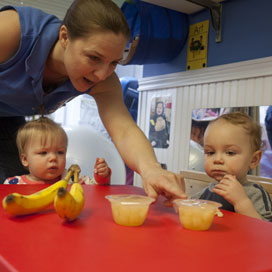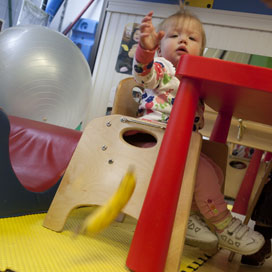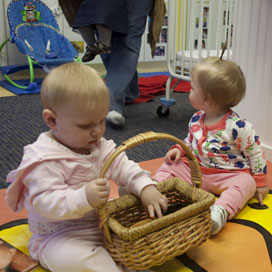
This is a great time for children to experiment with table foods. Make sure to have the families’ permission and to check the allergy list before feeding foods to the children. Make sure the pieces are small enough so the children don’t choke, but large enough for them to pick up easily. As they are eating, identify each food. “Oh! That’s a pear. It’s white and sweet tasting. Do you like it?” Give them an opportunity to respond before providing more dialog.
 This activity will teach the children independence. They will learn that they can communicate with you as they build their vocabularies. They will have the opportunity to explore their environment and new objects. They will also be building their eye-hand coordination.
This activity will teach the children independence. They will learn that they can communicate with you as they build their vocabularies. They will have the opportunity to explore their environment and new objects. They will also be building their eye-hand coordination.

When the children are done eating, let them experiment with gravity! They will love figuring out that every time they drop a toy, it falls to the ground. Although it may seem repetitive to you, they will be happy and occupied for many minutes. Speak to them as they play; say, “Oopsie!” as the toy goes down and “Here you go,” when you return it. Encourage them to repeat the phrases after you.
 This activity will teach the children independence as they learn that they can make things happen with their bodies. They will learn new vocabulary as they play and entertain one another.
This activity will teach the children independence as they learn that they can make things happen with their bodies. They will learn new vocabulary as they play and entertain one another.

Make a basket of items that the children can explore and that they will use in their real lives, such as hairbrushes, play phones, and sippy cups. Bring the basket to the carpet and allow the children to play with the items. As they play, talk about what the tools are called and demonstrate how to use them. Encourage the children to mimic your actions.
 This activity will help the children explore their surroundings as they learn about how tools are used. They will build their oral language skills and vocabularies. They will learn to get along with their peers and to become familiar with you and other adults.
This activity will help the children explore their surroundings as they learn about how tools are used. They will build their oral language skills and vocabularies. They will learn to get along with their peers and to become familiar with you and other adults.
